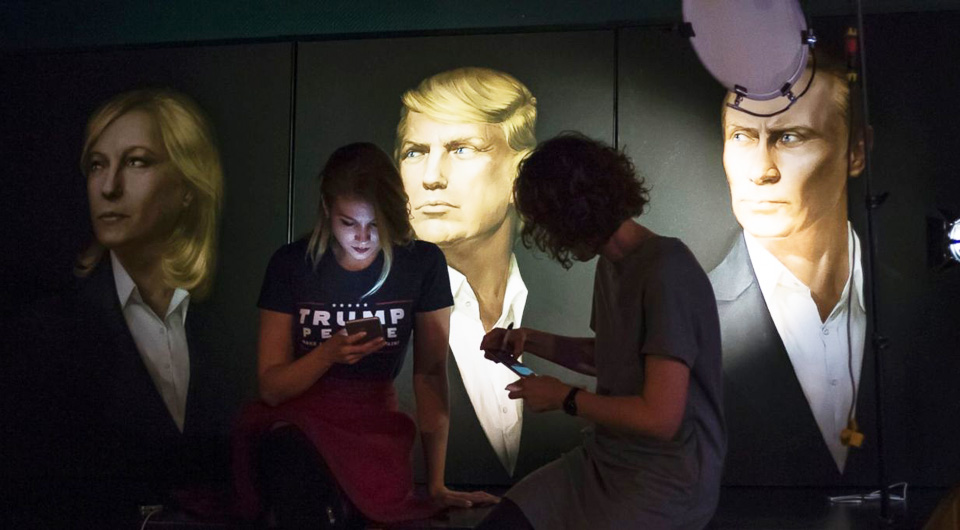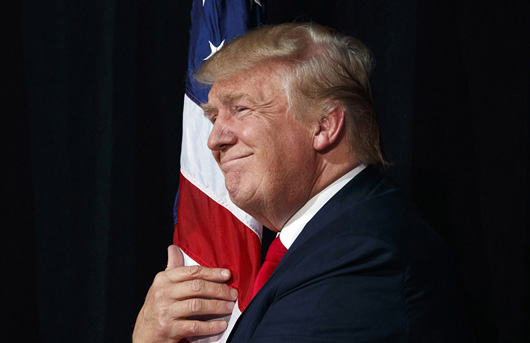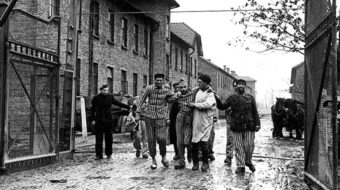
From Athens to Paris, Manila to Washington, and all points in between, the authoritarian right is on the rise globally. As historian Geoff Eley has written, “a politics that begins to look like fascism” is now coalescing in many countries. Ever since the Great Recession broke in 2008-09, “the system” has faced sustained scrutiny. Skepticism about how and in whose interest our economic and political architecture works has shaken the way society operates. Glaringly undeniable inequality has meant that people are more aware of where they fall in the class ladder, although consciousness of economic class interests fails to keep pace.
The ensuing loss of certainty about what once passed for business as usual means that radical solutions – on both the left and the right – have received a new hearing. Although there have been remarkable gains for the left in the United States – movements like Occupy Wall Street, the Fight for $15, the Bernie Sanders candidacy, and Hillary Clinton’s popular vote win – it is clear after November that it is the right which currently has the wind at its back. The Trump electoral college victory and GOP Congressional wins have placed the U.S. solidly in line with a global trend of growing right-wing power.
In country after country, the populist right is outmaneuvering left and progressive forces and positioning itself as the anti-establishment alternative. In some places, like Russia and the Philippines, strongmen have consolidated their positions as the personification of this new order. In others, such as France, Germany, Austria, and Greece, far-right movements pose a growing danger to polite political society. Even in societies where center-left forces and the ethic of multiculturalism maintain considerable strength, like Canada, rightist imitators are emerging.
Though each of these movements and leaders are unique products of their respective societies, common factors explaining why they are all growing in influence at the same time can be found in international political and economic developments. And as might be expected, their ideological underpinnings also run in often parallel directions. Highlighting the traits shared by these disparate movements is important not only for understanding the dynamics of world politics, but also necessary for crafting domestic and international responses to them.
Why now?
For more than thirty years, the global economic system has been progressively chipping away at the foundations of democracy. Academics and left political economists have been talking about it for decades, but it was only with the bursting of the housing bubble and the onset of the Great Recession of 2008 that the rest of us were all hit square in the face with that reality.
Neoliberalism – the policy package of privatization, deregulation, free trade, and capital mobility that the public has been sold since the late 1970s – steadily and stealthily undermined the functioning of many of our democratic practices. The natural process of greater internationalization of life under capitalism was subjectively molded in a particular direction –the phenomenon we have come to call globalization.
From the 1980s to the 2000s, free trade meant the apparent surrender of national political control over economics and job creation. To those losing out economically, it seemed that national-level governments were either no longer able to make decisions that were in the best interests of “their” people or, worse, they had sold them out. Some theorists, like William Robinson, began to ruminate on the development of a “transnational state” representing the interests of a “globalist bloc” of transnational capitalists and financiers that was institutionalized in bodies like the IMF, the World Bank, and the WTO.
International trade tribunals and treaties overrode domestic sovereignty. Power appeared to be moving from the national level upward to some anonymous and manipulative international elite. (I say “appeared” because in reality globalization has always been both an objective as well as subjective process: the unfolding of tendencies natural to capitalist development and the result of the conscious actions and decisions of nation-states. It wasn’t so much that national governments didn’t matter anymore, simply that the national governments of the most powerful capitalist states – and one in particular – continued to matter a lot more than all the rest.)
By the time of the global financial crisis, it looked as though economics was an area of policy that now existed outside the bounds of democratic debate or control. There was a palpable sense, for those who give thought to such things, of losing power – of helplessness in the face of global economic forces and the power of the international financial establishment.
Money, or capital, could move at will across the world as investment and profitability concerns dictated. Labor, meanwhile, was either bound within national borders and obliged to accept reduced wages and benefits and casual work, or forced to seek out opportunities to migrate in search of work (legally if possible, illegally when necessary).
Institutions could not be trusted, so the understanding goes, for it was the very politicians who operate the machinery of the state that accepted and abetted this transfer of power and control to their financial masters. Democracy, in the eyes of many, was something bought and paid for. Billion-dollar election campaigns proved the rule.
The threat of terrorism, ever-present since 9/11, further contributed to the feeling that nothing was sure anymore. Security threats produced fear. Fear enabled political manipulation.
At the same time, the gaping chasm of inequality opened ever wider. It became increasingly difficult not to see where one stood in the blatant bipolar division of society into the fabled 99 percent and 1 percent.
All these things, or some version of them, happened. The real dispute lies in how we interpret them, how to pinpoint the responsible parties, and how to fix the problems they’ve created.
Under such circumstances, class is now being reconstituted. People have become more aware of their position within society’s class hierarchy. Of course, this class awareness does not automatically translate into class consciousness. As one Trump supporter recently told the Canadian magazine Maclean’s, “American politics needs Donald Trump’s unorthodox approach… He connects with those of us that get up every day, go to work, raise families, pay taxes, give to and support our local churches and non-profits.” (Never mind the oil CEOs, public education adversaries, and anti-minimum wage opponents he has appointed to cabinet.)
Knowing where you stand on the ladder doesn’t always mean you therefore know where your interests lie or who your allies are. Intensifying social polarization does, however, lead to further questioning of old democratic ideals like pluralism, due process, coalition-building, checks-and-balances, and the rule of law. As that same Trump supporter said, “Mr. Trump embodies our distaste for and disgust with an out-of-control government. I cheer his unwillingness to conform to expectations.”
Prevailing norms have become tarnished. Old certainties have disappeared. Among many, a desire for a new order has developed. The predictability of the past (whether it truly existed or not) is looked back on fondly. This loss of faith in the system is overlaid upon and intertwined with pre-existing prejudices of nation, race, faith, and ethnicity to create a dangerous politics.
With the international political-economic order facing such a legitimacy and credibility crisis, what is the program that the authoritarian right offers?
The right’s promise: National renaissance
Marx and Engels are rightly considered the founders of the modern study of ideology. They said that ideologies are, more often than not, philosophical concealments of actually existing material reality. They saw ideology as a class-bound abstraction from the real world intended to shield capitalist class dominance from scrutiny. Drawing from their work, as well as that of Gramsci and others, contemporary political theorist Michael Freeden has formulated a way of looking at ideologies that focuses on their core concepts.

In practice, he argues, ideological dominance is exercised through the control of language – of thought itself. Ideologies, he says, can be understood as clusters of concepts that are given particular meaning by groups and individuals as they compete for control of public policy and social development. If you are able to control what an idea or concept means, you can control political discussion. And when you can control the latter, you are better able to head off potential challengers.
If we follow Freeden’s approach, what core concepts can we outline for the emerging global right bloc? Although it would be necessary to take into account national specifics in order to make such formulations more concrete, it is still possible to discern a general conceptual pattern among the various populist right movements.
Nation
In response to globalization’s supposed downgrading of the nation-state and the smothering conformity of official multiculturalism, all of the resurgent right-wing movements assert a need to restore their respective countries’ previous glory. In this sense, they are all grouped around a notion of national renaissance – a rebirth of the nation.
It is a political instinct that charts the future by looking backward to the past. In seeking a spiritual revival of the nation, supporters are led to believe that material revival will inevitably follow. With faith will come the resurrection.
In France, there is the Front National of Marine LePen which places concerns for protecting French culture from foreign invasion front and center. In Germany, Frauke Petry, known in the press as Adolfina, and her anti-immigrant Alternative for Germany (AfD) present a policy based on securing the border from illegitimate refugees and asylum-seekers. For these two, and other European right populists, Islam is portrayed as the key cultural aggressor. The religious crusade aspect merges with the national.
And in the U.S., we have the promise by Trump to turn the country “around from despair and anger to joy and accomplishment” – to “Make America Great Again.” He tells his followers that the nation has been “crippled” by “incompetence…beyond belief” at the executive and Congressional levels. Restoring the crippled nation to greatness implies also the need to secure its borders. So with his wall, Trump is on the same path being tread by LePen and others. As Bill Fletcher, Jr. reminds us, it is not possible to talk of right-wing populism without also talking about race.
Scholar Roger Griffin says such ideas are centered on the vision of “the national community rising phoenix-like after a period of encroaching decadence which all but destroyed it.” He was writing about the fascist movements of the 1920s and 30s. Circumstances today are different, but the historical echoes are getting harder to deny.
Authority
The incompetence of those who have allowed the nation to fall into economic malaise and opened the borders to outsiders must be overcome with the authority and power of a strong leader. As Trump says, “This mess calls for leadership…someone with common sense and business acumen, someone who can truly lead America back to what has made us great in the past.”
A modern-day Duce with the ability to stand as the symbolic embodiment of the popular will is the answer to a political system characterized by weakness abroad and corruption at home. The call was sounded in Cleveland last summer at the Republican National Convention: “I am your voice.”
The focus on the individual leader is a shared trait of most of today’s ascendant right-wing movements. The collectivism, multi-racialism, and political correctness associated with progressives and the left are eschewed in favor of the singular and unmuzzled representative of popular desire.
Trump’s kindred spirit in Moscow, Vladimir Putin, bothers even less with the emotional appeal. As far back as 1999, when he first became prime minister under Russian president Boris Yeltsin, Putin remarked rather directly: “I cannot cover all the tasks facing the government… But I do know one thing for sure: not one of those tasks can be performed without imposing basic order and discipline in this country, without strengthening the vertical chain.”
Again, the parallels to the classical fascist “Führerprinzip,” or leader principle, are easy to discern among the groupings of the global authoritarian right, even if still in embryonic form.
Sovereignty
Combined with the emphasis on national rebirth is a twisted vision of economic independence and political-military sovereignty among today’s authoritarians. The supposed threat to this independence is both internal and external. Immigrants and refugees threaten to dilute the national character and depress wages, job growth, and social services. Outside the borders, meanwhile, the “globalist elite” seeks to manipulate and denigrate countries for their own economic gain. Foreign powers take advantage of national weakness in order to assert their dominance.
In former colonial nations like the Philippines, this is manifested in a morphing of the language of the old national liberation movements of the 1960s and 70s. Would-be dictator Duterte laments his country’s “shackling dependence” on the U.S. and vows to free the nation.
Meanwhile, Trump rails that the U.S. is weakened by misleadership and outsmarted by other countries. “No one respects us,” he says. The alternative is to “operate from strength” – “maintain the strongest military in the world” and “demonstrate a willingness to use our economic strength to reward those countries that work with us and punish those countries that don’t.” Carry a big stick and don’t be afraid to use it.
The props of the autarky routine of the 1930s are unpacked and paraded once more in the form of calls for ending trade agreements like NAFTA and imposing “border taxes” on foreign products. Another aspect of national renaissance is this mythology of total economic independence backed by an unmatched military machine.
Are they fascist?
The authoritarian right populist movements growing across Europe, Asia, and now North America share many abstract similarities with the classical fascisms of the past. In some cases, particularly in western and central Europe, direct lineages can be traced between the parties and groups of today and the national socialist and fascist movements of the interwar period. For them, the neo-fascist character of their programs is undeniable.
In the U.S., it is still somewhat easier for the Trumpist movement to deny such a label for itself. The proudly declared connections to the so-called alt-right, the white nationalist off-shoot from mainline conservatism, and the questionable international associations of many in the Trump cabinet and transition team, however, are making that a harder sell.
Even with the conceptual ideological parallels, the growing international connections with other neo-fascist parties and personalities, as well as the direct intertwining of reactionary business and political interests (already well covered in the pages of this publication), haphazardly applying the fascist label onto all of these movements – including Trumpism – would be premature and politically unhelpful.
As outlined above, there are numerous signposts suggesting we are moving along the authoritarian and nationalist road, but comparing Trump, for instance, to Mussolini or Hitler would still be a stretch at this time. To do so debases the horrors experienced by those dictators’ victims and devalues the struggle that was faced by the anti-fascists of the 1930s and 40s.
Avoiding overestimating the danger, though, does not imply letting down our guard or easing up on formulating the tactics of resistance. Progressives should not panic and sensationalize the threat of the authoritarian right, but rather they should remain sober-minded and attentive as developments unfold.
In 1932, British fascist leader Oswald Mosley, in his book The Greater Britain, encapsulated the mythology of his movement’s vision: “In an age of decadence and disillusion when all old values fail, the new flame purifies and inspires to loftier ambitions and mightier ends.” In 1936, a powerful coalition of labor, socialist, Jewish, and other activists blocked the Mosley movement. By the outbreak of the war, his fascist party was finished.
The task today is to make sure that the contemporary authoritarians are just as unsuccessful at carrying out their goals as Mosley was.












Comments